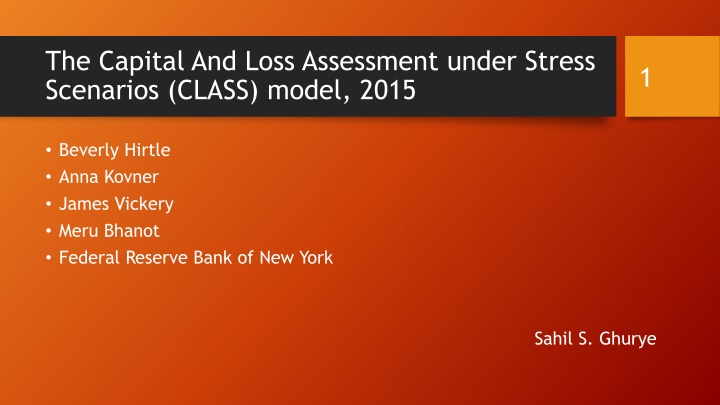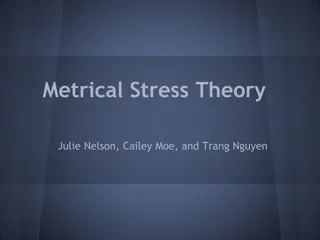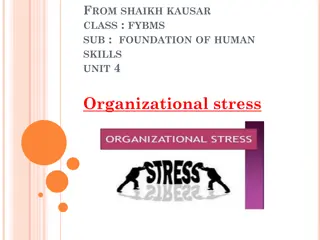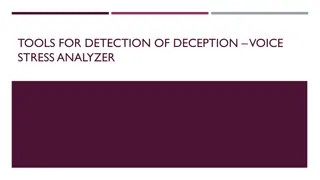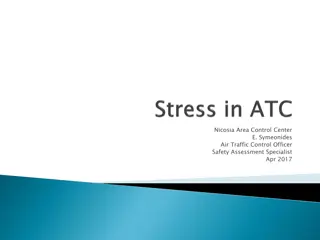Capital and Loss Assessment under Stress Scenarios Model
This content discusses the Capital and Loss Assessment under Stress Scenarios (CLASS) model, financial crisis assessments, data sources, projections of income and capital for banks, and factors influencing capital ratios. The CLASS model uses regression equations to predict net income and assess capital under macroeconomic scenarios. It analyzes how banks' capital and ratios are affected by economic stress scenarios and risky assets.
Download Presentation

Please find below an Image/Link to download the presentation.
The content on the website is provided AS IS for your information and personal use only. It may not be sold, licensed, or shared on other websites without obtaining consent from the author.If you encounter any issues during the download, it is possible that the publisher has removed the file from their server.
You are allowed to download the files provided on this website for personal or commercial use, subject to the condition that they are used lawfully. All files are the property of their respective owners.
The content on the website is provided AS IS for your information and personal use only. It may not be sold, licensed, or shared on other websites without obtaining consent from the author.
E N D
Presentation Transcript
The Capital And Loss Assessment under Stress Scenarios (CLASS) model, 2015 1 Beverly Hirtle Anna Kovner James Vickery Meru Bhanot Federal Reserve Bank of New York Sahil S. Ghurye
Financial Crisis 2 Supervisory Capital Assessment Program (SCAP) Dodd Frank Act 2008 Financial Crisis Comprehensive Capital Analysis and Review (CCAR) European Banks Stress Test
Introduction to CLASS model 3 Econometric Models Top-Down Capital Stress Test Public Data Auxiliary Assumptions
Data 4 Drawn from Federal Reserve Y-9C for BHCs and FFIEC Consolidated Reports (Call reports) for commercial banks for balance sheets, Income and loan performance Quarterly from 1991 to Q3 2013 All US Head Quartered Banks, top tier BHCs and independent commercial banks 6 large foreign owned BHCs subject to CCAR Panel of 200 largest banks ; All others are pooled together to form a 201st bank
CLASS Model 5 Projections of Commercial Bank and Bank Holding Company income and capital under macroeconomic scenarios Based on Regression of components of Bank Income, Banks Expense and Loan Performance Assumptions about provisioning dividends, asset growth and other factors Relies on public information unlike CCAR, DFAST, European Stress Test Uses 22 regression equations to predict Net Income Used Auto Regression in all regressions and uses OLS
CLASS Model Contd. 8 Banks most likely to see a decline in capital under stressful economic scenario also have high current capital ratios; banks holding risky assets also hold high capital buffers Regression data used to project various financial ratios (Net interest Margin, net charge off rates), conditional on macro data Ratios are converted to dollar values by multiplying loan balances, securities balance, or assets Loss, revenue and expense projections used to project pre tax net income Assumptions about dividends, taxes and regulatory capital rules along with growth of risk weighted assets give us capital and capital ratios
Regression Equation Structure 9 Each Regression model Key income or expense ratio as a function of autoregressive term Set of macroeconomic variables Some are times series Ratiot= + 1 * ratiot-1 + 2 *Macrot + t Ratiot is financial ratio of interest, ratiot-1 is autoregressive term Some models are estimated using pooled data (NIM, AFS) Ratiot,i= + 1 * ratiot-1,i + 2 *Macrot,i + 3 *Xt,i,+ t X is a vector of firms specific characteristics Autoregressive implies that projected ratio converge slowly towards a long run steady state value
Net Income Formula 11 Assumptions Realized Gain/Losses on HTM Securities and Extraordinary items and other adjustments are zero. Minority Interest = Previous Period
Pre Provision Net Revenue (PPNR) 12 Net Interest Income + Net Interest Income ( Eg. Interest Income Interest expense) Non Interest Non Trading Income Ratio +Non Interest Income ( Eg. Deposit fees, fiduciary activities, IB fees and insurance) Non Interest Trading activities +Return on Trading Assets ( Eg. Derivatives, spread income on trading) Non Interest Expense -Compensation Noninterest Expense ratio -Fixed Asset Noninterest expense ratio (eg. Premises use) -Other Noninterest Expense ratio
Correlations for PPNR 14 Variable Correlation 1 Correlation 2 Net Interest Margin Short term Yield Slope of yield Curve Trading Returns Credit spreads (BBB 10 year) - Non trading non interest returns Stock markets returns - Compensation Expense Stock returns - Non Interest expense Credit Spreads -
Net Charge Offs (NCOs) 16 Residential Real Estate Commercial Real Estate Commercial and Industrial Consumer Loans All Other Loans First Lien Residential Construction Commercial and Industrial Credit Card Foreign Governments Junior Lien Residential Multifamily Other Consumer Home Equity Line of Credit Non Farm Non residential Depository Institutions Other Real Estate Agriculture Other
Net Charge Off Rates (Contd.) 18 Real Estate loans related to real estate price downturns Mortgage default represents a put option on underlying real estate (Kaul et al, 1992) Real Estate declines have larger effect on charge off rates than real estate price increase Final Equation Includes dummy variable to check if Price Index is less than 0 Others related - Unemployment Rate
Net Charge Off Rates Correlation (Contd.) 19 Variable Correlation 1 Correlation 2 Residential Real Estate Home price growth Home price growth if growth is negative - Commercial Real Estate Commercial Property Price growth if negative Annualized Change in unemployment Commercial and Industrial - Consumer Loans Annualized Change in unemployment Annualized Change in unemployment - Other loans Commercial Property Growth
Available for Sale Securities (AFS) 21 Firm sells assets or securities deemed to have experienced Other than temporary impairment AFS low and stable except during 2008-2009 Affected by Credit Factors Asset Price Shocks Credit Events Behavioral Decisions about Asset Sales Accounting Judgement Model includes interaction term between risky AFS securities and increases in Credit spread Negatively correlated to changes in Treasury Bond yields
Calculating Capital Gap (Common Equity/Risk Weighted Assets) 25 Capital Gap is the capital needed to bring each BHC to a certain capital ratio Compute and estimate of system wide undercapitalization ($100 billion in 2002 and $540 billion in 2008) assuming 8% threshold Capital gap falls significantly after 2009 Equity Issuance by firms Lower Dividends Return to profitability
Previous Graph 27 Between 2004 Q1 and 2008 Q4, Assets increased by 33% but Capital Gap increases by 83% ($113 Billion to $206 Billion) Signifies deterioration of capital adequacy in years leading up to crisis Seen nearly 4 years before $8.5 Billion in 2013 Q3 significantly lower than 2002 also! Shows that s banks are better capitalized now.
Assumptions - Balance Sheet Growth 28 Total Assets 1.25% per Quarter Banking Industry grows more slowly in stressed Environments than expansion Banking Sector moves with Macro economy historically particularly with Term Spread and Credit Spread Increase in Term Spread Shift from Loans to Securities Increase in Credit Spread Shift from trading assets and fed funds to cash and securities portfolio
Assumptions - Allowance for Loan and Lease Losses (ALL) 29 Model projects NCOs for each quarter Under accounting rules, NCOs don t affect Net Income and instead recognize provision expense incurred to increase Allowance for ALLL ALLL is estimated by firm and hence needs management discretion it s not straight forward; Hence CLASS Model assumes range If ALLL is at least equal to next 4 quarters of projected NCOs, but not greater than 250%, Provision expense is equal to NCO If ALLL is below next 4 quarters NCOs, Provision expense is equal to amount that would bring ALLL to that level If ALLL is greater than twice next 4 quarters NCOs, then Provision expense is negative to bring ALLL down to that level
Assumptions - Taxes 30 Banks are Assumed to pay 35% statutory Tax rate There are limits that Deferred tax assets can be carried forward
Assumptions - Dividends 31 Change in Equity is determined by Net Income and Capital Actions like: Dividends on both common and preferred shares Share repurchases New Shared Issuance No share repurchases or issuances Assumes Dividends converge to payout ratio, averaged to 40-50% of net after tax Dividendst=max(a*Dividendst-1 + (1-a)*[Dividendst* - Dividendst-1],0) Dividendst*=45% * After Tax Net Income a= Speed of Adjustment parameter (0.9)
Sensitivity to Assumptions 32 Asset Growth Rate Assumed at 1.25% Sensitivity done at -01.25%, 0.00% and 2.50% Loan Loss Provisioning Rule Sensitivity to 4 Quarter rule setting ALLL equal to next 4 quarter of NCOs Payout Rule Sensitivity Dividends remain same, benchmark rule (45%), Dividends are equal to zero Firms must have a tier 1 common ratio above 6 Tier 1 common ratio = (Common Stock + Retained Earnings + Accumulated other comprehensive income + Non cumulative perpetual stock) / Weighted Risky Assets
Comparing CLASS and CCAR projections 34 CLASS Model CCAR Modeling Approach Top-down Model Bottom-up Model Data Publicly available from Call and 9-YC filings Detailed supervisory information from individual BHCs Coverage Top 200 largest BHCs and independent banks 30 BHCs with assets exceeding $50 billion Dividends Converging to a long-run average payout ratio relative to Net Income Fixed at recent historic levels and assumes no repurchases Balance Sheet Growth Stylized assumptions for all institutions in all scenarios Various across institutions and scenarios Trading and Counterparty Trading revenues based on macroeconomic scenarios Separate instantaneous global market shock on 6 largest BHCs
Shortcomings 35 No feedback from banking system to Macro economy Macroeconomic projections are treated as exogenous Used to predict Net Income and Regulatory Capital under certain macroeconomic scenario Shouldn t be used for a specific bank or BHC
Why is it useful? 36 Model projections can be generated quickly by adjusting assumptions Can be used as a benchmark against other top-down models Show vulnerability as back as 2004, before any market indicators Can use recent data to project income and capital in a few minutes for a single macroeconomic scenario Use fed data to test for various scenarios (Next Slide) Can be improvised and developed
Fed Data 37 Real GDP growth Unemployment rate 10-year Treasury yield BBB corporate yield Date Baseline Adverse Baseline 2.2 -1.5 2.3 -2.8 2.4 2.3 -1.5 2.4 -0.5 2.4 2.4 2.3 2 2.1 2.1 2 2 Adverse Baseline Adverse Baseline Adverse 4.2 4.4 4.5 4.6 4.7 4.8 4.9 5 5.1 5.1 5.2 5.2 5.2 2017 Q1 2017 Q2 2017 Q3 2017 Q4 2018 Q1 2018 Q2 2018 Q3 2018 Q4 2019 Q1 2019 Q2 2019 Q3 2019 Q4 2020 Q1 4.7 4.6 4.6 4.5 4.5 4.5 4.4 4.4 4.5 4.6 4.6 4.7 4.7 5.2 5.8 6.3 6.8 7.1 7.3 7.4 7.3 7.2 7.1 2.5 2.6 2.7 2.9 2.3 2.4 2.5 2.5 2.6 2.7 2.7 2.7 2.7 2.7 2.7 2.7 2.7 5.6 5.9 6.1 6.2 -2 3 6 1 3.1 3.2 3.3 3.4 3.4 3.5 3.5 3.5 5.8 5.6 5.4 5.2 1.4 2.6 2.6 3 3 3 3 5 7 4.8 4.7 4.5 6.9 6.8
Thank you! 38 Sources : https://www.newyorkfed.org/medialibrary/media/research/staff _reports/sr663.pdf https://www.federalreserve.gov/supervisionreg/ccar-2017.htm
